A hysterectomy is the surgical removal of the uterus, otherwise known as the womb. Rarely is a hysterectomy an emergency surgery. There is usually considerable time to research and explore options for discussions with your personal surgeon.
During a hysterectomy the uterus is completely or partially removed. The fallopian tubes and ovaries may also be removed depending on the health needs of the woman.
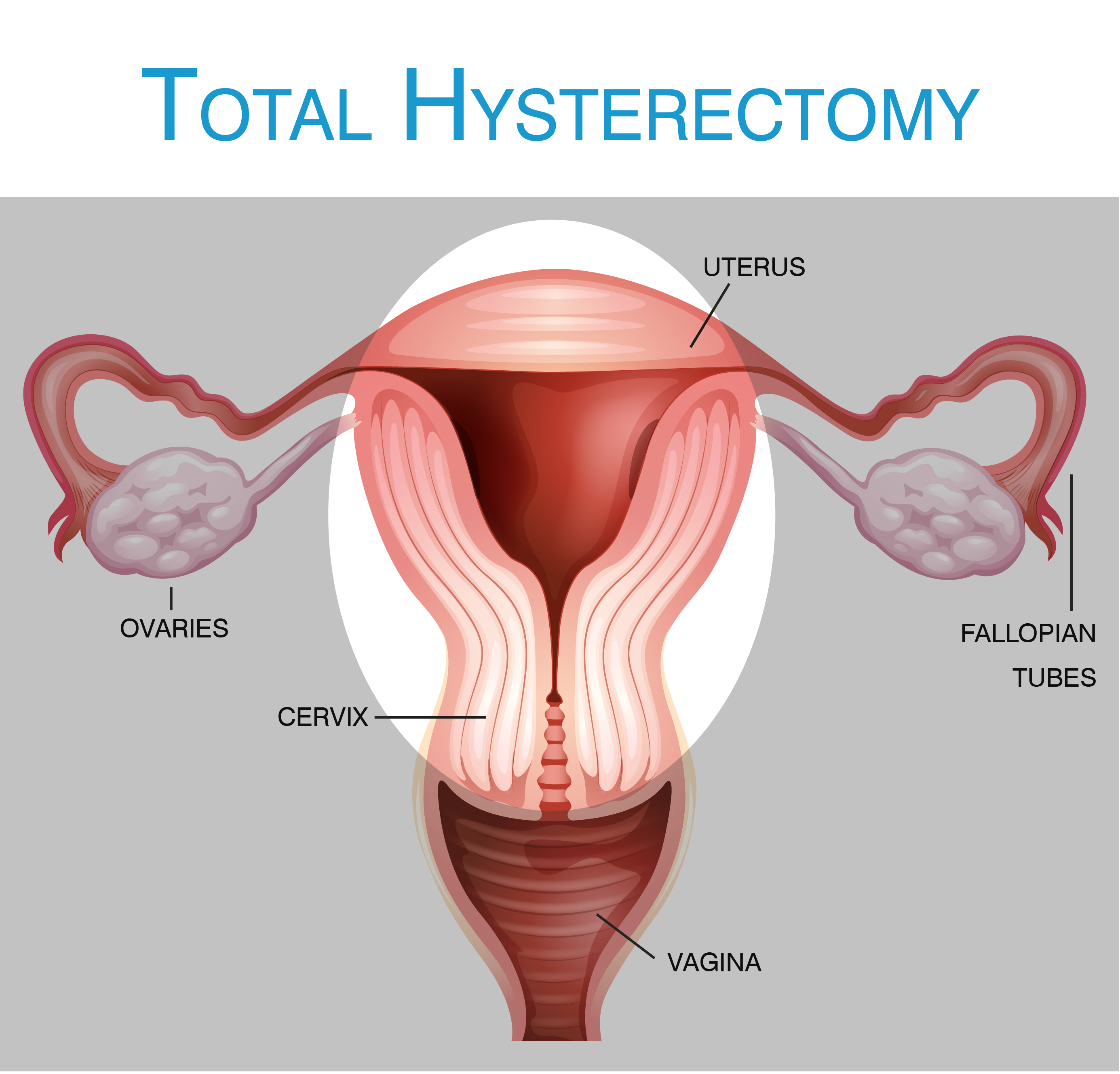
A total hysterectomy is removal of the entire uterus which includes the cervix. A radical hysterectomy is the removal of the uterus, the tissue on both sides of the cervix (parametrium), and the upper part of the vagina.
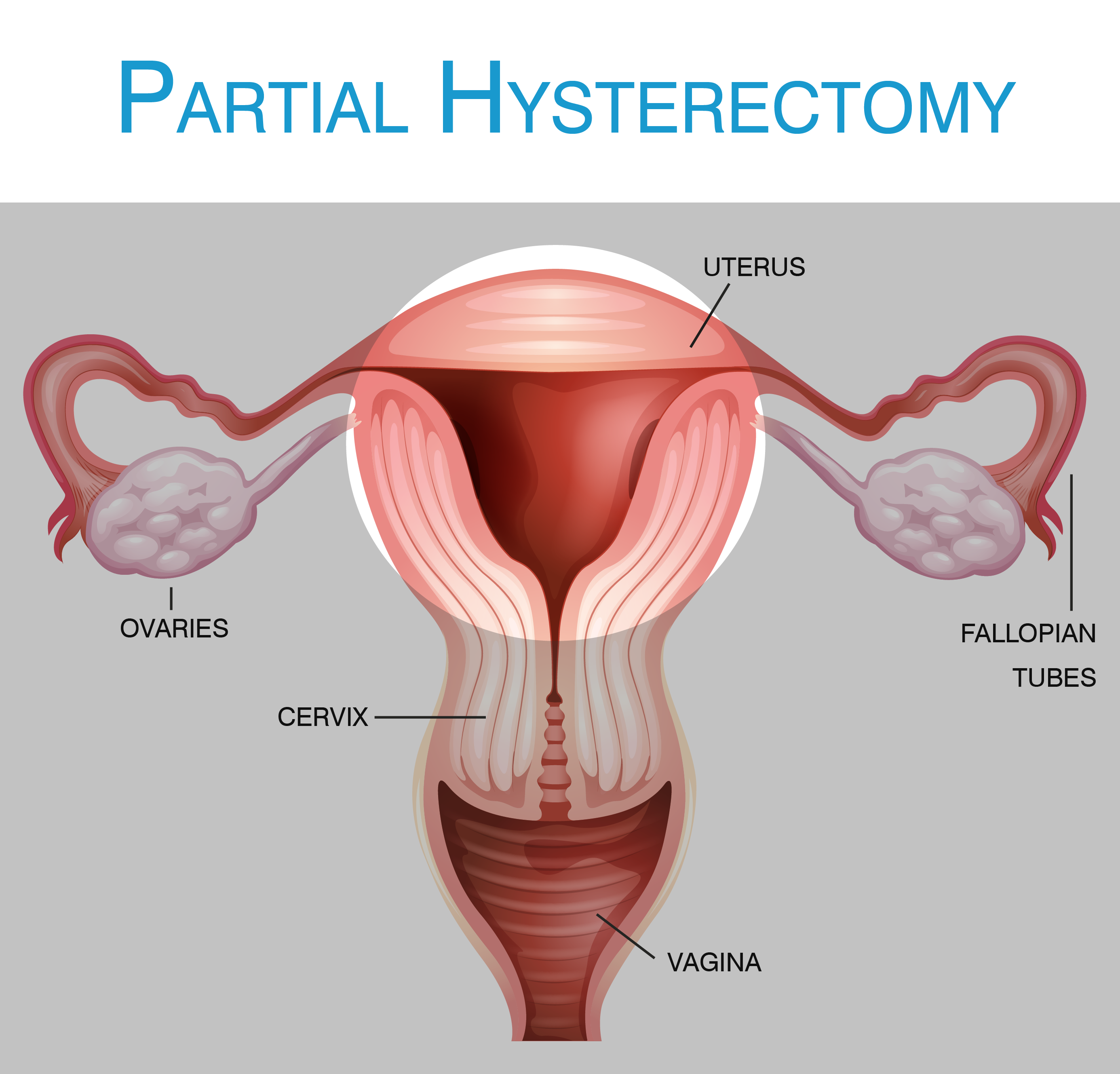
A partial (or supracervical) hysterectomy is removal of just the upper portion of the uterus, leaving the cervix intact.
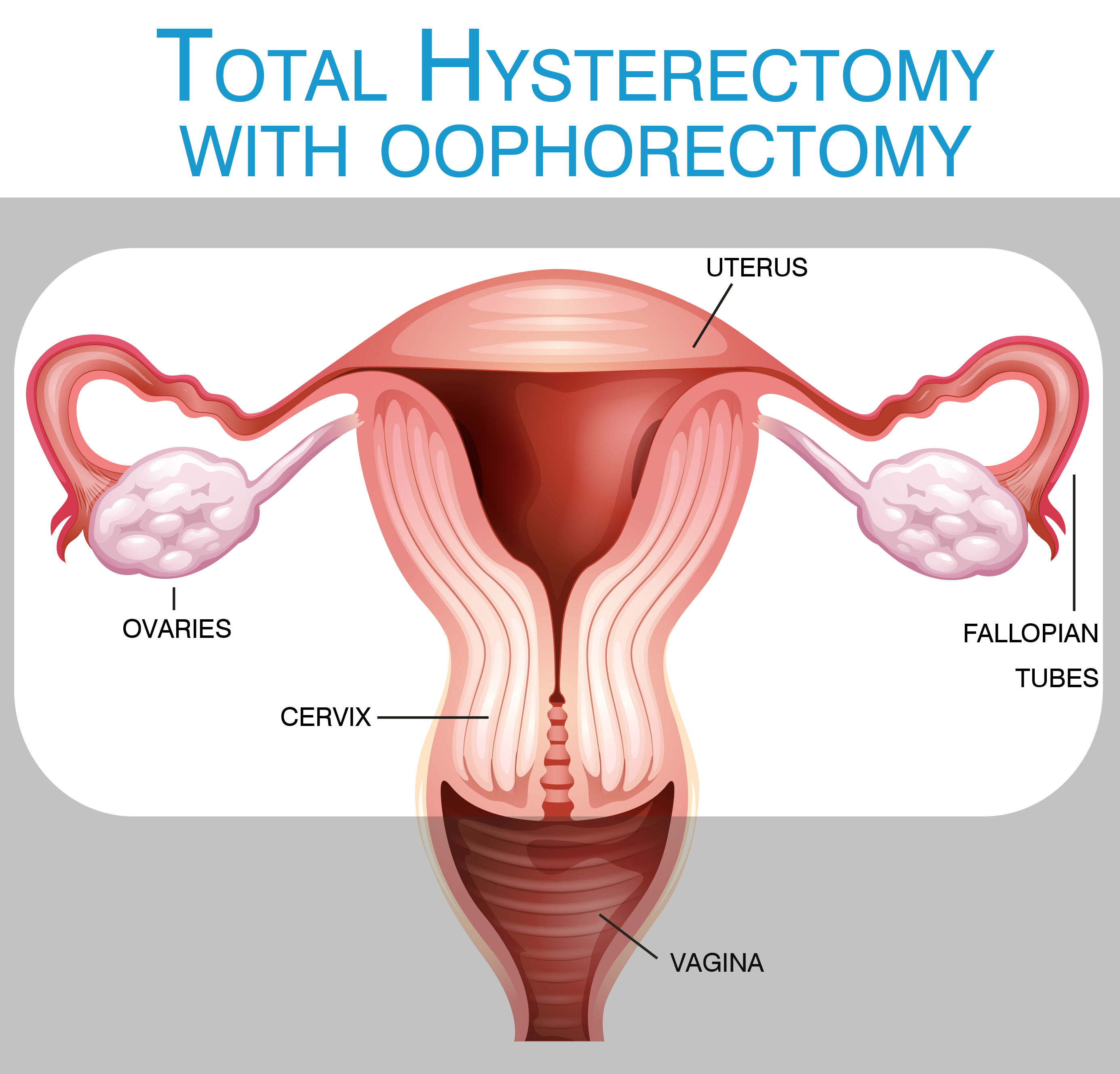
A hysterectomy is the surgical removal of the uterus, otherwise known as the womb. The removal of the ovaries in addition to a hysterectomy – is called an oophorectomy.
Hysterectomy Types
An abdominal hysterectomy is abdominal surgery for the removal of the uterus. If your doctor has mentioned an abdominal hysterectomy, a horizontal incision or vertical incision will be made in the abdomen. The abdominal incision was once the most commonly performed hysterectomy.
Acronym: TAH
Description of procedure: The doctor makes a cut in the abdominal wall to expose the ligaments and blood vessels around the uterus. The muscles in the abdomen are usually not cut, but spread apart with retractors. The ligaments and blood vessels are separated from the uterus and the blood vessels tied off so they will heal and not bleed. Then, the uterus with the cervix, is removed by cutting it off at the top of the vagina. The top of the vagina is repaired by being sewn so that a hole is not left. This is called the vaginal cuff.
Indications/contra-indications: This type of hysterectomy is the most invasive of the surgery types and the one that may involve the longest recovery. There is risk of the incision becoming infected.
Initial Recovery: Expect 6 to 8 weeks of recovery, with lifting and straining restrictions for this whole period. It is also normal to expect to have a restriction on intercourse for the whole of the initial recovery period.
A vaginal hysterectomy is a surgical procedure done through the vagina, removing the uterus and cervix. If your doctor has mentioned a vaginal hysterectomy there will not be an incision in the abdomen. In recent years, the vaginal hysterectomy has become more common as technology provides for additional help to the surgeon. Sometimes this surgery is aided by the use of a laparoscope.
Acronym: TVH
Description of procedure: The doctor removes the uterus and cervix through a cut in the vagina. The top of the vagina is repaired by being sewn to form the vaginal cuff.
Indications/contra-indications: This is usually the surgery of choice if you have prolapse, if there is no possibility of cancer, if your uterus is not too enlarged and if you’ve delivered vaginally. This type of surgery is not recommended when the surgeon needs to have space to look around, if there is danger of cancer cells or of endo spreading, if you have not delivered vaginally or if your uterus is enlarged beyond a certain size. This surgery can entail additional bleeding. Due to the lack of the presence of an incision, it is easy to forget you’ve just had major surgery and run the risk of thinking that they are further ahead in their recovery.
Initial Recovery: Expect 6 to 8 weeks of recovery, with lifting and straining restrictions for this whole period. It is also normal to expect to have a restriction on intercourse for the whole of the initial recovery period.
Laparoscopic hysterectomy is a minimally invasive surgery to remove your uterus. There are many types of laparoscopic hysterectomy: Lap Assisted Vaginal Hysterectomy, Total Laparoscopic Hysterectomy, Laparoscopic Supracervical (partial) Hysterectomy, Robotic Hysterectomy and Single Site Laparoscopic Hysterectomy. Most women are candidates for laparoscopic hysterectomies.
Total Laparoscopic Hysterectomy
Acronym: TLH
The surgery will still be performed entirely laparascopically.
Description of procedure: Tiny cuts are made in the abdominal wall to provide access for laparoscope and other surgical instruments. The uterus is removed through the tiny cuts in portions.
Initial Recovery: Although a shorter recovery time because there are fewer incisions, expect 3 to 5 weeks of recovery, with some lifting and straining restrictions that could extend beyond this period.
Laparoscopic Assisted Vaginal Hysterectomy
Acronym: LAVH
Description of procedure: During a LAVH, several small cuts are made in the abdominal wall through which slender metal tubes called “trocars” are inserted to provide access for a laparoscope and other small surgical instruments. The laparoscope is like a tiny telescope with a camera attached to that provides a continuous image which is enlarged and projected onto a television screen. The uterus (including the cervix) is detached from the ligaments that attach it to other structures in the pelvis, and removed through a cut at the top of the vagina which is repaired with stitches.
Initial Recovery: Although a shorter recovery time because there are fewer incisions, expect 3 to 5 weeks of recovery, with some lifting and straining restrictions that could extend beyond this period.
Laparoscopic Supracervical Hysterectomy
Acronym: LSH
As you are making decisions about your hysterectomy, you may consider keeping your cervix. A supracervical hysterectomy removes the uterus but leaves the cervix in place, which some research suggests may reduce the risk of pelvic organ prolapse and preserve sexual function. This is sometimes referred to as “partial hysterectomy.”
Description of procedure: This procedure is done completely laparoscopically and does not remove the cervix. The uterus is cut up into small pieces and removed through the tubes which were inserted into the abdomen.
Initial Recovery: Although a shorter recovery time because there are fewer incisions, expect 3 to 5 weeks of recovery, with some lifting and straining restrictions that could extend beyond this period.
Single Site Laparoscopic Hysterectomy
Acronym: SS or LESS or SILS
Description of procedure: This procedure is done through an approximately one inch single incision in the fold of the belly button which avoids the large six to eight inch incision made in the lower abdomen involved in typical open hysterectomy and the multiple (3 – 5) approximately one inch incisions required for standard laparoscopic surgery. This new advanced surgical technique reduces the pain and minimizes the scarring compared to open surgery. One day in the hospital is typical.
Initial Recovery: Expect 3 to 5 weeks of recovery, with some lifting and straining restrictions that could extend beyond this period.
Acronym: DVH or RAH
Instead of a large incision used in open surgery, surgeons operate through one (single site) or a few small incisions – similar to traditional laparoscopy to remove the uterus. Although it is often called a “robot”, the da Vinci System cannot move or operate on its own. Your surgeon is 100% in control of the System. Specialized technology of the robot features a magnified 3D high-definition vision system and tiny wristed instruments that bend and rotate far greater than the human wrist.
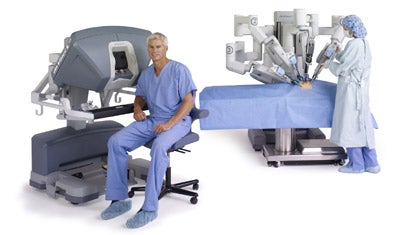
Description of procedure: Just as with laparoscopic hysterectomy, one or more tiny cuts are made in the abdominal wall to provide access for laparoscope and other surgical instruments. The uterus is removed through the tiny incisions in portions or removed through the vagina.
Initial Recovery: Expect 2 to 6 weeks of recovery, with some lifting and straining restrictions.
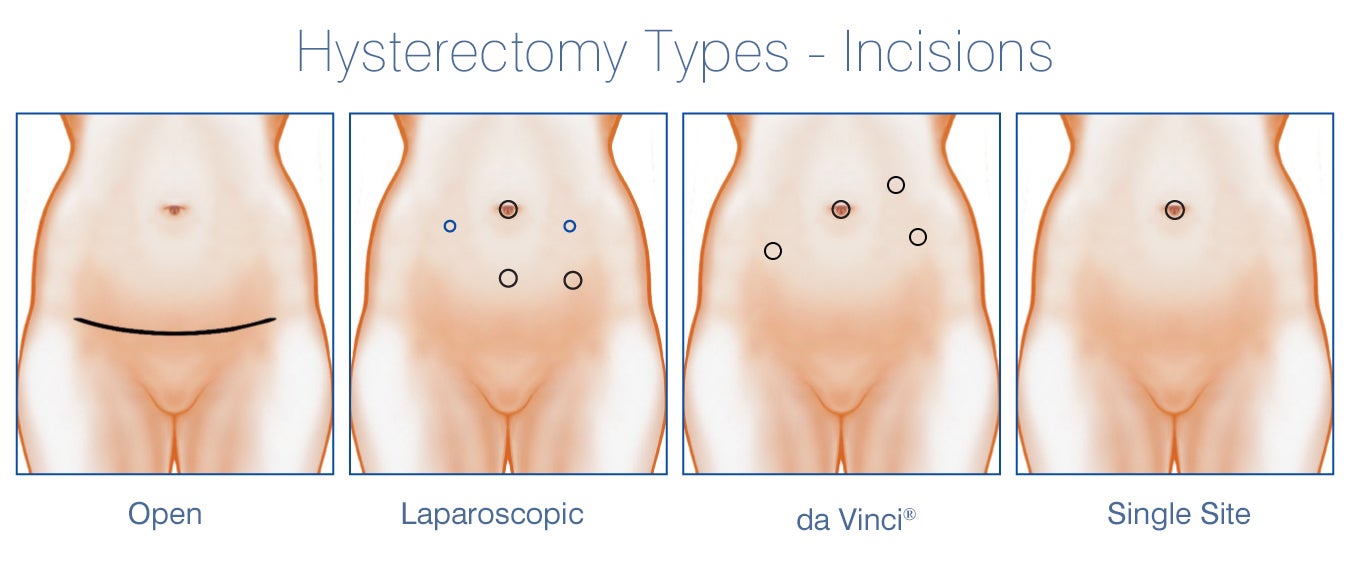
Your physician will help you decide which type of hysterectomy is most appropriate for you, depending on your medical history and the reason for your surgery.
According to WomensHealth.gov A hysterectomy is the second most common surgery among women in the United States. The most common surgery in women is childbirth by cesarean section delivery.
According to ACOG, there are over 500,000 hysterectomies performed in the USA every year. Learn more HYSTERECTOMY FACTS.



